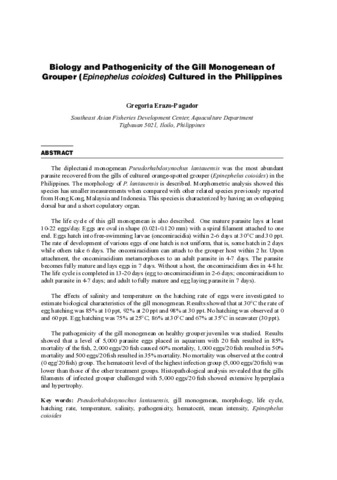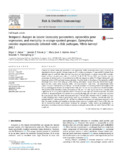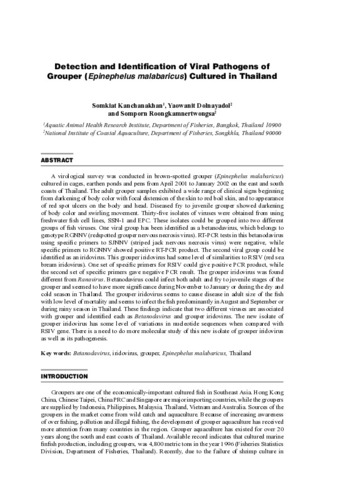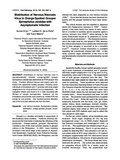Perlihatkan publikasi sederhana
Biology and pathogenicity of the gill monogenean of grouper (Epinephelus coioides) cultured in the Philippines
| dc.contributor.author | Erazo-Pagador, Gregoria | |
| dc.contributor.editor | Nagasawa, Kazuya | |
| dc.date.accessioned | 2020-07-22T05:44:12Z | |
| dc.date.available | 2020-07-22T05:44:12Z | |
| dc.date.issued | 2005-03 | |
| dc.identifier.citation | Erazo-Pagador, G. (2005). Biology and pathogenicity of the gill monogenean of grouper (Epinephelus coioides) cultured in the Philippines. In K. Nagasawa (Ed.), Recent Advances in Diagnosis and Prevention of Fish and Shrimp Diseases in Southeast Asia (pp. 295–308). Tigbauan, Iloilo, Philippines: Aquaculture Department, Southeast Asian Fisheries Development Center. | en |
| dc.identifier.isbn | 9718511732 | |
| dc.identifier.uri | http://hdl.handle.net/10862/5935 | |
| dc.description.abstract | The diplectanid monogenean Pseudorhabdosynochus lantauensis was the most abundant parasite recovered from the gills of cultured orange-spotted grouper (Epinephelus coioides) in the Philippines. The morphology of P. lantauensis is described. Morphometric analysis showed this species has smaller measurements when compared with other related species previously reported from Hong Kong, Malaysia and Indonesia. This species is characterized by having an overlapping dorsal bar and a short copulatory organ. The life cycle of this gill monogenean is also described. One mature parasite lays at least 10-22 eggs/day. Eggs are oval in shape (0.021-0.120 mm) with a spiral filament attached to one end. Eggs hatch into free-swimming larvae (oncomiracidia) within 2-6 days at 30°C and 30 ppt. The rate of development of various eggs of one hatch is not uniform, that is, some hatch in 2 days while others take 6 days. The oncomiracidium can attach to the grouper host within 2 hr. Upon attachment, the oncomiracidium metamorphoses to an adult parasite in 4-7 days. The parasite becomes fully mature and lays eggs in 7 days. Without a host, the oncomiracidium dies in 4-8 hr. The life cycle is completed in 13-20 days (egg to oncomiracidium in 2-6 days; oncomiracidium to adult parasite in 4-7 days; and adult to fully mature and egg laying parasite in 7 days). The effects of salinity and temperature on the hatching rate of eggs were investigated to estimate biological characteristics of the gill monogenean. Results showed that at 30°C the rate of egg hatching was 85% at 10 ppt, 92% at 20 ppt and 98% at 30 ppt. No hatching was observed at 0 and 60 ppt. Egg hatching was 75% at 25°C, 86% at 30°C and 67% at 35°C in seawater (30 ppt). The pathogenicity of the gill monogenean on healthy grouper juveniles was studied. Results showed that a level of 5,000 parasite eggs placed in aquarium with 20 fish resulted in 85% mortality of the fish, 2,000 eggs/20 fish caused 60% mortality, 1,000 eggs/20 fish resulted in 50% mortality and 500 eggs/20 fish resulted in 35% mortality. No mortality was observed at the control (0 egg/20 fish) group. The hematocrit level of the highest infection group (5,000 eggs/20 fish) was lower than those of the other treatment groups. Histopathological analysis revealed that the gills filaments of infected grouper challenged with 5,000 eggs/20 fish showed extensive hyperplasia and hypertrophy. | en |
| dc.language.iso | en | en |
| dc.publisher | Aquaculture Department, Southeast Asian Fisheries Development Center | en |
| dc.subject | Epinephelus coioides | en |
| dc.subject | pathogenicity | en |
| dc.subject | groupers | en |
| dc.subject | Philippines | en |
| dc.subject | Monogenea | en |
| dc.title | Biology and pathogenicity of the gill monogenean of grouper (Epinephelus coioides) cultured in the Philippines | en |
| dc.type | Book chapter | en |
| dc.citation.spage | 295 | en |
| dc.citation.epage | 308 | en |
| dc.citation.bookTitle | Recent Advances in Diagnosis and Prevention of Fish and Shrimp Diseases in Southeast Asia | en |
| dc.subject.asfa | pathogens | en |
| dc.subject.asfa | grouper culture | en |
| dc.subject.asfa | parasites | en |
| dc.subject.asfa | salinity | en |
| dc.subject.asfa | temperature | en |
| dc.subject.asfa | morphology | en |
| dc.subject.asfa | gills | en |
| dc.subject.asfa | life cycle | en |
| dc.subject.asfa | hatching | en |
| dc.subject.asfa | water temperature | en |
| dc.subject.asfa | statistical analysis | en |
| dc.subject.asfa | fish eggs | en |
| dc.subject.scientificName | Pseudorhabdosynochus lantauensis | en |
Files in this item
Publikasi ini ada di koleksi berikut
-
Recent Advances in Diagnosis and Prevention of Fish and Shrimp Diseases in Southeast Asia [43]
Terminal Report of the Regional Fish Disease Project on “Development of Fish Disease Inspection Methodologies for Artificially-Bred Seeds” Funded by the Government of Japan Trust Fund from 2000 to 2004


 AQD Access only
AQD Access only



